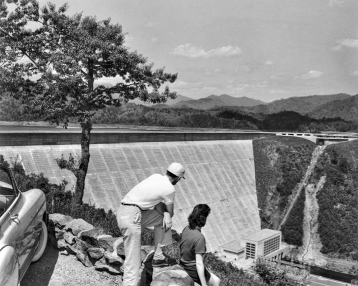Fontana Dam
Fontana Dam, the largest dam of the Tennessee Valley Authority (TVA) system, is located on the Little Tennessee River in Graham County. Completed in 1945, it is a gravity-type concrete structure 480 feet high, 2,365 feet long, and 376 feet thick at its base. The six-story powerhouse of reinforced concrete with glass walls is located at the base of the dam. Typical of TVA engineering, Fontana is multipurpose, providing electric power, flood control, navigation, and recreation.
Fontana Dam was developed as a part of the war effort. Formerly owned by the Aluminum Company of America, the site had been acquired by the TVA after prolonged negotiations. Because it was situated in a remote, mountainous area about 60 miles from both Knoxville, Tenn., and Asheville, N.C., highways, bridges, and rail lines had to be built to bring in construction equipment, supplies, and workers.
In this wilderness, the TVA built a community for 5,000 workers and their families. The construction camp included 19 dormitories, a cafeteria with a capacity to serve 1,000 people, a community building, a recreation facility, refreshment stands, and a softball field. The permanent village, a mile downstream from the dam site, included nearly 400 houses and 400 trailers. The village featured a 50-bed hospital, a business district, two racially segregated schools, libraries, softball fields, recreation buildings, refreshment stands, and movie theaters.
Fontana's employees maintained three eight-hour shifts, around-the-clock, seven days a week. Because of this accelerated schedule, construction time was slashed almost to half of what it would have been in peacetime. To inspire the workers, military marches and big band music was piped over an intricate public address system that reached the camp, ball fields, cafeteria, and recreation halls. Bright floodlights illuminated the site, and signs everywhere reminded the inhabitants of their patriotic mission in the war effort.
In November 1944 Fontana Lake began to fill, inundating and submerging small towns in the area like Proctor, Forney, Almond, and Japan. On 20 Jan. 1945, three years after construction had started, the powerhouse produced electricity for the first time. The project had cost $74.7 million, consumed 2.8 million cubic yards of concrete, and required 34.5 million man-hours to build. The dam created a reservoir of more than 11,000 acres with a 240-mile shoreline and a drainage area of more than 1,500 square miles.
By the early 2000s, the three generating units at Fontana Dam had a total productive capacity of 225,000 kilowatts. In addition, the TVA controlled flooding of the Little Tennessee River through a process of storing and releasing water from the reservoir. Recreational activities included fishing, boating, and swimming on Fontana Lake. The Appalachian Trail, which extends over 2,000 miles from Georgia to Maine, crosses the top of Fontana Dam.
References:
Carl Condit, American Building (1968).
Jack Igelman, "Fontana's Lost Towns" (2014). https://wncmagazine.com/feature/fontana%E2%80%99s_lost_towns
Marguerite Owen, The Tennessee Valley Authority (1973).
Additional Resources:
National Park Service, Fontana Dam: http://www.nps.gov/grsm/planyourvisit/fontanadam.htm
"Man-Made Marvels," Our State, March 2002. https://digital.ncdcr.gov/Documents/Detail/our-state/1052094
"Japan, NC". North Carolina Gazetteer.
1 January 2006 | Glass, Brent D.
